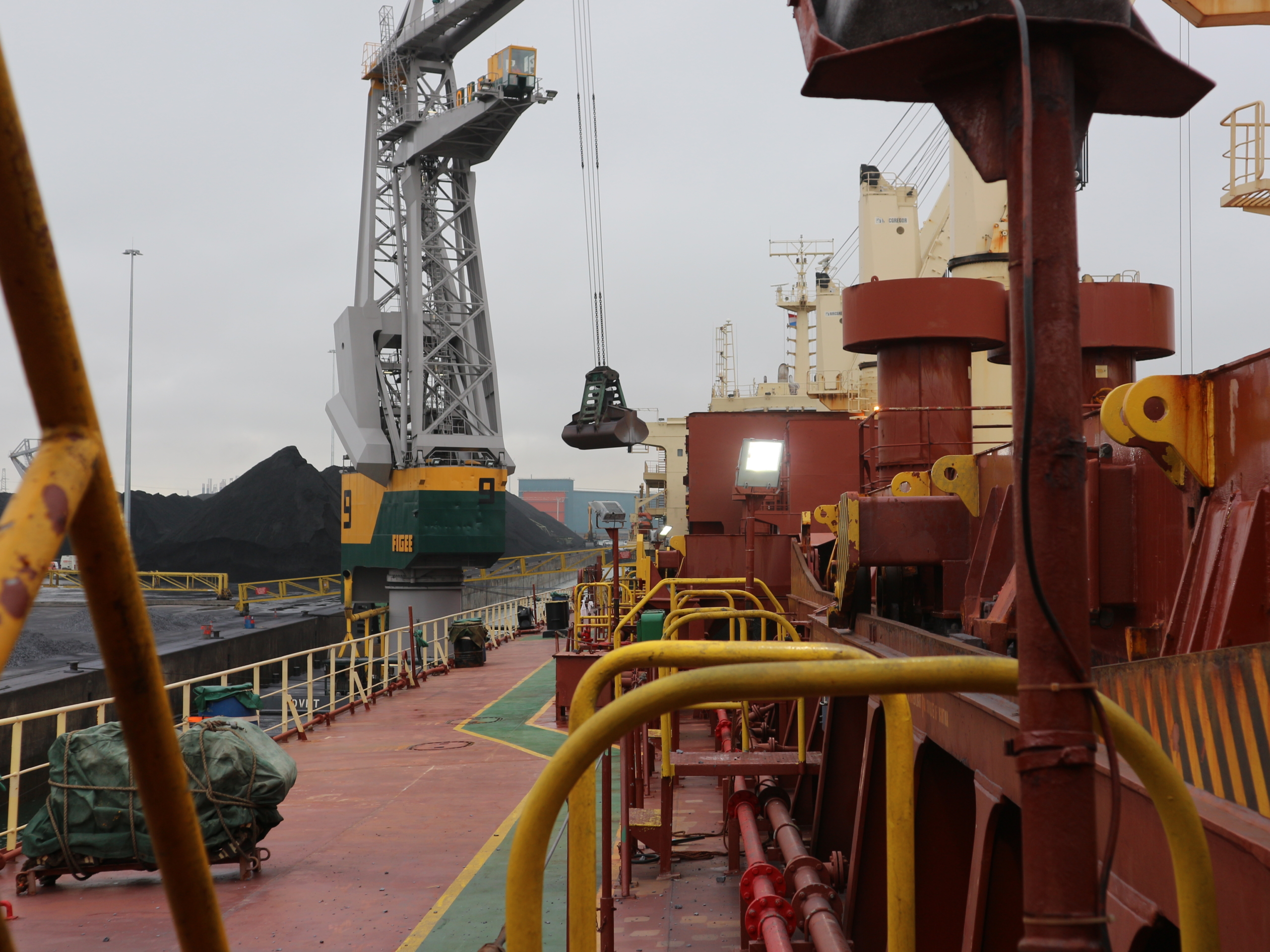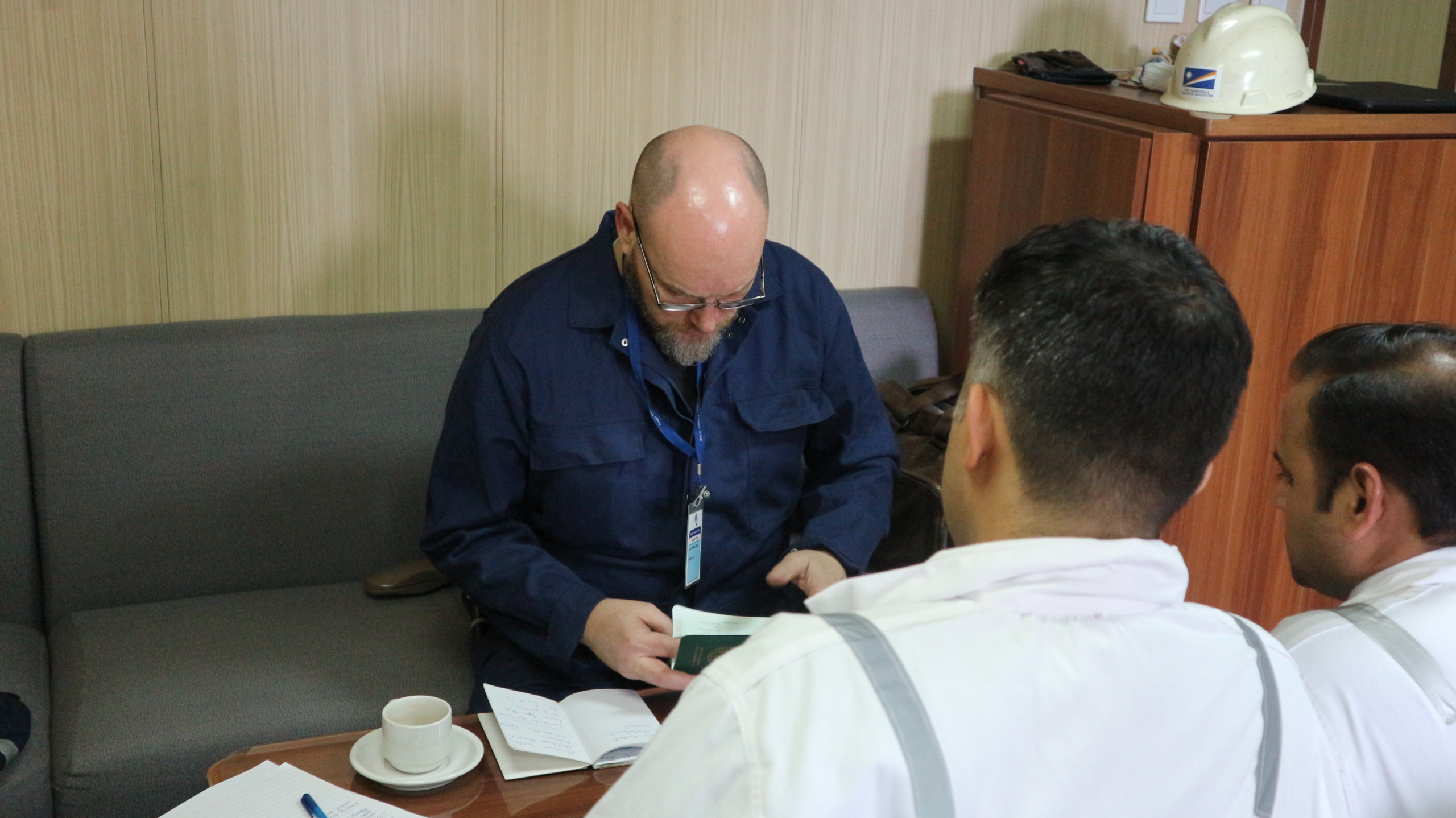

The Marshall Islands Report accompanies Hans Krijger, General Manager, IRI Roosendaal on a ship inspection to find out.
On a cold windswept winter morning at a coal terminal in Vlissingen, south Holland, Hans Krijger casts a critical eye over the supramax bulk carrier discharging its cargo.
“She looks like she’s seen better days,” he says looking at the slightly battered hull. “Let’s see what it’s like aboard.”
First impressions count, and Hans Krijger has his concerns. Hans Krijger has been a ship inspector with International Registries, Inc. (IRI), which provides administrative and technical support to the Republic of the Marshall Islands Maritime and Corporate Registries, since it opened its Roosendaal office in 2008. Almost equidistant between two (2) of Europe’s busiest ports, Antwerp and Rotterdam, and within striking distance of Ghent, Vlissingen, and Amsterdam, IRI’s Roosendaal office inspects around 200 vessels a year. Hans Krijger leads a team of exclusive inspectors responsible for inspections across North West Europe, Spain, the Middle East, India, and Africa.
Today we are conducting a Quality Control Boarding (QCB) of a five (5) year old bulk carrier. QCBs are voluntary, free inspections undertaken by RMI inspectors around the world to help ensure that ships under the flag are in compliance with critical items and therefore unlikely to fail a port State control (PSC) inspection. Initiated three (3) years ago, QCBs have helped ensure that the RMI fleet has a very low detention record. The program has focused particularly on bulk carriers, which have a higher level of detention rates than container ships and tankers. The program not only helps prevent detentions, but also provides the shipowner with an objective report about the condition of the ship, as well as giving the RMI Registry an impression of the ship, helping to know if the ship has a high or low level of compliance.
Accompanying Hans Krijger for the day, it quickly became apparent that building a rapport with the crew early on is critical. He treats the crew with respect from the moment he boards the ship.
“It’s the little things that count. I always remove my work-boots before I enter the Master’s cabin and always accept the coffee that’s made for me. You must never forget that the ship is both a home and a workplace,” says Hans Krijger.
The first step on any inspection is to sit down with the Master and go through the paperwork thoroughly. Are all the mandatory certificates up-to-date? Have all the crew passes been signed? All too often, a ship can be detained by a PSC inspector because of a missing counter-signature. Today, a few counter-signatures are missing on the recently updated Standards of Training, Certification and Watchkeeping (STCW) paperwork and the relevant crew members are summoned to sign them.

“I think you need to be a people person to be a good inspector,” says Hans Krijger. “You need to understand where both the crew and PSC are coming from and they need to understand where you are coming from.”
He explains that it is all too easy to be bureaucratic and not let a ship sail for any number of small reasons.
“But you need to be pragmatic and have both sailing and surveying experience. Sometimes you have to be both creative and responsible to satisfy all parties that the ship should be allowed to continue its voyage.”
He adds: “I sometimes feel like a psychologist when I talk to clients and explain why the ship can’t be allowed to sail.”
Hans Krijger is an ex-engineering officer who sailed with Holland & America Line and worked ashore as a Superintendent. Today he is conducting a QCB inspection of the ship. Having spent an hour reviewing the paperwork, we go upstairs to the bridge where all systems are checked and double-checked. Everything is in order.
The next port of call is the lifeboats. All too often crews are solely focused on getting the ship safely from port-to-port and loading and discharging cargo. Attention to the equipment that could save their lives is, unfortunately, sometimes at the bottom of their priority list. One of the most frequent causes of PSC detentions is life-saving equipment related deficiencies. This is not the case with the lifeboats on our supramax, which are in full working order. “Very good Master!” says Hans Krijger with a big smile.

At the top of any inspector’s list will be fire safety. Fire detection and alarm systems, fire-fighting equipment, fixed fire extinguishing installations, fire prevention structures, and fire dampers are all checked with great thoroughness. Throughout his four (4) hours on board the supramax, Hans Krijger will check the fire screen doors, making sure that they shut properly. The ship’s fire safety equipment is found to be in full working order.
An important part of the inspection will be a lunch with the senior officer team. The crew of the supramax is from the Gujarat and Goa regions of India, so a tasty Indian curry is served up for our inspector. Lunch is spent sharing experiences.
“I think connecting with the crew members is very important,” says Hans Krijger. “We see so many ships and it’s vital that we get across the importance of what we’re doing and why safety really matters to the crews. Anecdotes of what’s gone wrong on other ships really help the crew understand the importance of inspections.”
The afternoon is then spent checking everything from the galley, paint storeroom, and sick bay to the engine room. Fire dampers are tested, alarm systems checked, and questions are constantly asked. It is clear that Hans Krijger is passionate about his job and really wants to ensure that the ship is safe.
“Being a flag inspector is not quite the same as being a PSC inspector,” he says. “I think perhaps in some ways there is more job satisfaction. We are able to track the ship’s performance, talk to the Designated Person Ashore, and suggest ways to make improvements. We have a relationship with the ship, the crew, and the shore team.”
We end our day with a report to the Master on the inspection’s findings. Good news, the ship has passed with flying colors. It’s well run, and despite initial misgivings based on the ship’s appearance after a tough winter criss-crossing the Atlantic, the vessel is found to be highly compliant. Next stop is New Orleans and another possible inspection by the United States Coast Guard.



